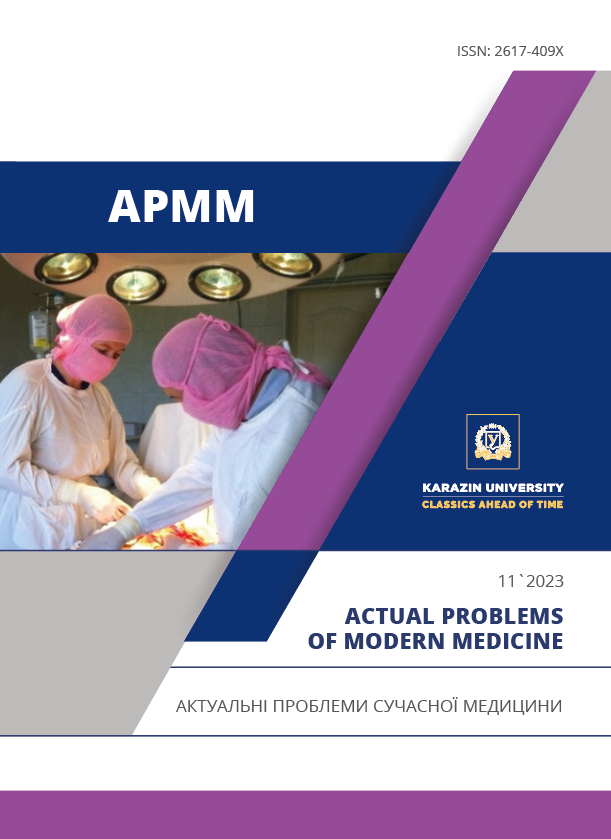The corrective effect of Au/Ag/Fe nanoparticles on oxidative stress in terms induced colon adenocarcinoma
Abstract
ABSTRACT. Studying biological markers of oxidative stress is crucial and relevant, as this process can trigger the transition from an organ's "normal state" to a "malignant lesion". The use of metal nanoparticles to correct oxidative stress manifestations in oncology is one of the most popular subjects of modern science and is actively being introduced into modern medicine. Practically all possible types of nanoparticles have found their use in solving different problems in oncology. Therefore, our study aimed to investigate the possibility of Au/Ag/Fe nanoparticles use for the correction of redox balance disorders of the antioxidant system under the conditions of induced colon adenocarcinoma. Materials and methods. The study was performed on 150 white male rats. Animals were kept in standard vivarium conditions. Division of experimental rats into groups: I - control intact group (40 individuals); II - experimental group (70 individuals) with N,N-dimethylhydrazine hydrochloride administration once a week for 30 weeks; ІІІ – an experimental group (40 animals) with daily intragastric administration of Au/Ag/Fe nanoparticles. Oxidative stress was assessed in colon tissue homogenate by changes in the concentrations of 8-iso-prostaglandin F2α (8-iso-PGF2α), TBC-active products, diene and triene conjugates, Schiff bases, as well as by the activities of catalase, superoxide dismutase, glutathione peroxidase, glutathione reductase, and reduced glutathione. Results. Due to this research, we established that Au/Ag/Fe nanoparticles use leads to a decrease in the concentration of 8-iso-prostaglandin F2α (8-iso-PGF2α), TBC-active substances, diene, triene conjugates, Schiff bases. As a result of the above, we observed a reduction of manifestations of oxidative stress and restoration of enzymes of the antioxidant system and its biological mediators of a non-enzymatic nature. The activity of catalase, superoxide dismutase, glutathione peroxidase, and the concentration of reduced glutathione was restored to control indicators. Conclusions. Therefore, the use of Au/Ag/Fe nanoparticles leads to the restoration of the balance of redox equilibrium, improving the antioxidant system with induced adenocarcinoma of the large intestine.
Downloads
References
Lisnychuk NYe, Soroka YuV, Andriichuk IYa, Stravska MYa, Yavorska SI. Influence of induced carcinogenesis on biological markers of endotoxemia. World of Medicine and Biology. 2018;1(63):137-140. DOI: https://doi.org/10.26.724/2079-8334-2018-1-63-137-140
Lushchak VI. Free radicals, reactive oxygen species, oxidative stresses and their classifications. Ukr. Biochem. J. 2015;6(87):11-18. DOI: https://doi.org/10.15407/ubj87.06.011
Zińczuk J, Maciejczyk M, Zaręba K. Antioxidant barrier, redox status, and oxidative damage to biomolecules in patients with colorectal cancer. Сan malondialdehyde and catalase be markers of colorectal cancer advancement? Biomolecules. 2019;9(10):63-71. DOI: https://doi.org/10.3390/biom9100637
Soroka Y, Andriichuk I, Lykhatskyi P, Fira L, Lisnychuk N. (2020) Violation of the prooxidant-antioxidant balance in the spleen tissue under experimental carcinogenesis. Georgian Med News. 2020; (308):123–128. PMID: 33395653. Available from: https://www.geomednews.com/Articles/2020/11_2020/123-128.pdf
Ou X, Liu Y, Zhang M. Plasmonic gold nanostructures for biosensing and bioimaging. Microchim Acta. 2021;188:304. DOI: https://doi.org/10.1007/s00604-021-04964-1
Rieznichenko LS, Doroshenko AM. Safety assessment of the iron NP – a substance with antianemic properties – under the oral administration to rats. Veterinary biotechnology. 2020; 37:63-75. DOI: https://doi.org/10.31073/vet_biotech37-07
Datta A, Mishra S, Manna K. Pro-oxidant therapeutic activities of cerium oxide nanoparticles in colorectal carcinoma cells. ACS Omega. 2020;26(17):9714-9723. DOI: https://doi.org/10.1021/acsomega.9b04006
Trahtenberg ІM, Ischeikin KE, Dmytruha NM, Andrusyshyna ІМ, Kozlov КP, Legkostup LА, Capko VG. Eksperymentalne doslidzhennja vplyvu koloidnyh rozchyniv oksydu zaliza z nanjchastynkamy na sercevo-sudynnu system schuriv. Svit medycyny ta biologii. 2022;3(81):236-241. [in Ukrainian]. DOI: https://doi.org/10.26724/2079-8334-2022-3-81-236-241
Lisnychuk N, Dybkova S, Rieznichenko L, Vivchar Z. Can Au/Ag/Fe nanoparticle composition restore blood cell counts in terms of_DMH-induced colon adenocarcinoma. Modern issuens of medicine and management. 2021;2(22):18-32. DOI: https://doi.org/10.52340/mid.2021.638
ASC De-Souza, TA Costa-Casagrande. Animal models for colorectal cancer. ABCD Arq Bras Cir Dig. 2018;31(2):1365-1369. DOI: https://doi.org/10.1590/0102-672020180001e1369
Rytsyk O, Soroka Y, Shepet I, Vivchar Z, Andriichuk I, Lykhatskyi P, Fira L, Nebesna Z, Kramar S, Lisnychuk N. Experimental Evaluation of the Effectiveness of Resveratrol as an Antioxidant in Colon Cancer Prevention. Natural Product Communications. 2020;6(15):1-10. DOI: https://doi.org/10.1177/1934578X20932742
European convention for the protection of vertebrate animals used for experimental and other scientific purposes. – Council of Europe, Strasbourg, 1986:56.
Kozhemyakin YuM, Hromov ОS, Filonenko МА. Naukovo-praktychni rekomendacii z utrymannya laboratornyh tvaryn ta roboty z nymy. K.: Avicena, 2002:156. [in Ukrainian].
Vlizlo VV, Fedoruk RS, Ratych ІB. Laboratorni metody doslidzhen u biologii, tvarynnyctvi ta veterynarnii medycyni: dovidnyk.; za redakcieyu V.V. Vlizla. L.: Spolom, 2012:764. [in Ukrainian].
Statystychni metody obrobky rezultativ medykobiologichnyh doslidzhen: metodychni vkazivky./ uporjadkovano: TV Levchrnko, EB Radzishevska. Harkiv: HNMU, 2016:39. [in Ukrainian]. Available from: https://repo.knmu.edu.ua/handle/123456789/13270
Nour Eldin EEM, Nour Eldein MM, El-Readi MZ, Mirza AA, Fatani SH. Evaluation of the diagnostic and predicative values of 8-Iso-
Prostaglandin F2α as a biomarker of breast cancer. Oncology research and treatment. 2020.10;(43):506-516.
DOI: https://doi.org/10.1159/000509671
Herasymchuk NM. 8-isoprostane as the main marker of oxidative stress. Zaporozhye medical journal 2018;20(6),853–859. DOI: https://doi.org/10.14739/2310-1210.2018.6.146780
Godovanec OІ, Vitkovskyi ОО, Kuznyak LV, Murynyuk ТІ. Funkcionuvannya glutationovoi systemy rotovoi ridyny ditei za umov rozvytku odontogennogo zapalnogo procesu. Bukovynskyi medychnyi visnyk. 2020;3(95):16-21. [in Ukrainian]. DOI: https://doi.org/10.24061/2413-0737.XXIV.3.95.2020.66




